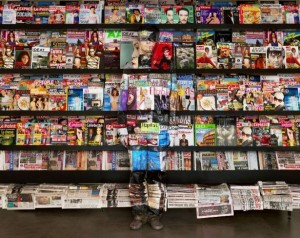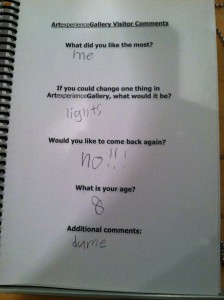Liu Bolin’s work allows for creative ways to gain a certain level of visitor participation. For instance his “Hiding in the City No. 98 Info Port,” made me wonder if a traditional notice board, as depicted by the artist, could be placed in the center of Gallery 1, or the atrium, where visitors could post comments. For First Thursdays, maybe the notice board could be worn by a volunteer and could move around the museum, as is almost suggested by Bolin’s work here.
A Top Forty type voting system to rate his pictures by the audience would be easy to organize. The results could be displayed in the atrium or on the aforementioned “Info Port.”
Hiding in the City No. 98 Info Port
Similarly, “Hiding in New York No. 3 Magazine Rack” could give rise to an inexpensive participatory action: place a magazine rack close by the artwork (or in the sculpture court if too disruptive in the current display) and encourage people to photograph themselves as the artist has, and e-mail the photo to a museum website to be displayed and then rated by online voting. Perhaps it could be made more interactive by allowing guests to choose the magazines to be placed in the rack, rather than having them in the racks already (Guns and Ammo or Cosmopolitan, Harpers or National Review, etc.).
As another classmate remarked, Bolin’s work sometimes has a “Where’s Waldo” quality. Couldn’t that be used to encourage children to view the pictures: give them a sheet of paper with six of the pictures in black and white and have them find the pictures, search for Bolin and mark on the handout where he is.
Hiding in New York No. 3 Magazine Rack
Akio Takamori’s “Sleeping Woman in Black Dress” begs for a cot or masseuse table to be placed close by it so visitors could pose like the woman depicted. Or just to take a nap. Seriously, it made me want to take a nap and I mean that in a positive sense.
Sleeping Woman in Black Dress
I visited the Boise Art Museum in early February and found the best participatory part to be the children’s ARTexperience Gallery, just as a few other of our classmates did. The two computers in there worked, and quickly responded to input. Based on comments in the comment-book the chalkboard is highly popular (I also cannot resist writing on it!). There are artistic type puzzles, books, costumes, building blocks, magnetic stickers and a “poem clothes line.” One of Bolin’s pictures has been cut up and pasted on magnets to create a puzzle. However, no matter how hard you try you can’t make everybody happy as evidenced below.
Elsewhere in the museum, two computers are available to take a survey, share an opinion, leave a comment or send an e-postcard. However, neither was working when I visited, and the docent explained that the technology was old and prone to malfunctioning. At the front desk families can get an interactive pack for younger children that encourages interaction with the exhibits at a level most likely to engage younger children. Gallery 4 has a video exhibit that showed the artistic process Liu Bolin undergoes to create his works. Gallery 15 has a VCR/DVD player and several VCRs/DVDs on art that patrons can watch along with many art books for browsing. A touch screen display in Gallery 13 either was not working properly or was not intended to display information.




I like the idea of a Top 40 vote for Bolin’s exhibit. It was definitely the most interesting and thought provoking exhibit. Maybe there could even be an explanation component…”Why were you most drawn to that piece?”